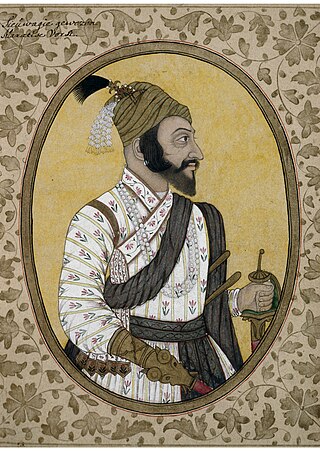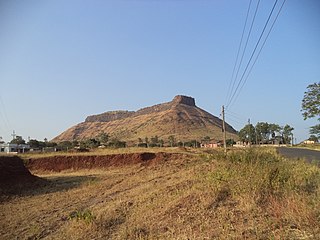
Shivaji I was an Indian ruler and a member of the Bhonsle dynasty. Shivaji carved out his own independent kingdom from the Sultanate of Bijapur that formed the genesis of the Maratha Confederacy.
Firangoji Narsala was a Maratha warrior and military leader in the army of Shivaji Maharaj, in 17th century India. He is famous for his defence of Sangram Durg, a fort, against a Mughal army led by Shaista Khan in 1660.

Rajaram Bhonsle I was the third Chhatrapati of the Maratha Kingdom, who ruled from 1689 to his death in 1700. He was the second son of Shivaji, the founder of the empire and younger half-brother of Sambhaji, whom he succeeded. His eleven-year reign was marked with a constant struggle against the Mughals. He was succeeded by his infant son Shivaji II under the regentship of his dowager Maharani Tarabai.

Mahur or Mahurgad is a town and religious place in Nanded district of Maharashtra, India. Mahur is the birthplace of Hindu God Dattatreya. Dattatreya parents Atri Rishi and Sati Anasuya Mata lived here. Brahmadev, Vishnudev and Lord Shiva once got a news about Anusaya Mata that there is no one more pious and pure as her. To test her piousness they arrived under the garb of asking Alm (bhiksha). Near Mahur, There is a Pious confluence of River Penganga and River Pus at Hiwara Sangam village, Tal. Mahagaon Vidarbha, from where the river flows northward. Penganga river forms a border between Vidarbha and Marathwada. Mahur falls just about 3kms inside Marathwada due to river banks.

The Deccan wars were a series of military conflicts between the Mughal Empire and the descendants of the Maratha ruler Shivaji from the time of Shivaji's death in 1680 until the death of Emperor Aurangzeb in 1707. Shivaji was a central figure in what has been called "the Maratha insurgency" against the Mughal state. Both he and his son, Sambhaji, or Shambuji, typically, alternated between rebellion against the Mughal state and service to the Mughal sovereign in an official capacity. It was common practice in late 17th-century India for members of a ruling family of a small principality to both collaborate with the Mughals and rebel.

The Battle of Pratapgad took place on 10 November 1659, at Pratapgarh Fort in Satara. The battle was fought between the Maratha forces led by Shivaji and the Bijapur troops under General Afzal Khan. The Marathas emerged victorious, marking their first significant military triumph against a major regional power. In the aftermath of this victory Shivaji captured 65 elephants, 4000 horses, 1200 camels and 10 Lakh rupees of cash and jewellery.

The battle of Surat, also known as the Sack of Surat, was a land battle that took place on 5 January 1664, near the city of Surat, in present-day Gujarat, India, between Shivaji, leader of the fledgling Maratha State and Inayat Khan, a Mughal commander. The Marathas defeated the Mughal military unit posted at Surat.

The Battle of Sinhagad, also known as Battle of Kondhana, involved an attack by Marathas during the night of 4 February 1670 on the Mughal fort of Sinhagad, near the city of Pune, Maharashtra. The Marathas captured the fort.

Mirza Abu Talib, better known as Shaista Khan, was a general and the Subahdar of Mughal Bengal, he was maternal uncle to the Mughal Emperor Aurangzeb, he acted as a key figure during his reign, Shaista Khan initially governed the Deccan, where he clashed with the Maratha ruler Shivaji, However, he was most notable for his tenure as the governor of Bengal from 1664 to 1688, Under Shaista Khan's authority, the city of Dhaka and Mughal power in the province attained its greatest heights. His achievements include constructions of notable mosques such as the Sat Gambuj Mosque and masterminding the conquest of Chittagong. Shaista Khan was also responsible for sparking the outbreak of the Anglo-Mughal War with the English East India Company.
Santaji Ghorpade (1660–1696) was a Maratha general and held the esteemed position of the 7th Senapati within the Maratha Empire during the reign of Chattrapati Rajaram I. He is widely regarded as one of the foremost experts in Guerrilla warfare. Santaji Ghorpade, in collaboration with Dhanaji Jadhav, conducted a series of successful campaigns against the Mughals from 1689 to 1696. His strategic acumen was demonstrated through the adept utilization of tactics such as guerrilla warfare, ambushes, and swift mobility, ultimately resulting in effective defeats of the Mughal Army. In recognition of his valor, Rajaram bestowed upon him the title of Mamlakat-Madar in 1690.

Ramchandra Neelkanth Bawadekar (1650–1716), also known as Ramchandra Pant Amatya, served on the Council of 8 as the Finance Minister (Amatya) to Emperor (Chhatrapati) Shivaji, dating from 1674 to 1680. He then served as the Imperial Regent to four later emperors, namely Sambhaji, Rajaram, Shivaji II and Sambhaji II. He authored the Adnyapatra, a famous code of civil and military administration, and is renowned as one of the greatest civil administrators, political thinkers, diplomats and military strategists of the Maratha Empire.

Prabalgad is a fort located between Matheran and Panvel and comes under the Raigad District in the state of Maharashtra, India.
The Battle of Chakan in 1660 took place between Mughal forces led by Shaista Khan and Maratha forces commanded by Firangoji Narsala at Chakan in Maharashtra. Shaista Khan's Mughal forces emerged victorious by besieging the Chakan fort, leading to the surrender of the Maratha commander Firangoji.
The Battle of Salher was fought between the Marathas and the Mughal Empire in February 1672 CE. The battle was fought near the fort of Salher in modern-day Nashik district. The result was a decisive victory for the Marathas. This battle is considered particularly significant as it is the first pitched battle where the Mughal Empire lost to the Marathas.

The Maratha Navy was the naval wing of the armed forces of the Maratha Confederacy, which existed from around the mid-17th century to the mid-18th century in the Indian subcontinent.
Achala Fort is a westernmost fort in the Satmala hill range. It is located 55 km from Nashik, in Nashik district, of Maharashtra. This fort is adjoining the Ahivant Fort. The three forts Achala, Ahivant, and Mohandar are very close by. The Achala and Mohandar forts were constructed to guard the Ahivant fort. Captain Briggs has described it as a large hill, whose ascent is very easy till it reaches the top where it is very steep.
Savitribai Deshmukh, better known by her title Rai Bagan or Raibagan, was a female Mughal general under the Emperor Aurangzeb. She was the widow of the Mughal sardar Raje Udaram Deshmukh of Mahur jagir in Deccan. After her son's death in Battle of Samugarh, she led her forces aiding the then prince Aurangzeb in the battle, which paved his way to become the emperor. The emperor conferred upon her the royal title. She aided Aurangzeb's uncle Shaista Khan in the Mughal campaign against the Maratha empire's founder Shivaji.

Siege of Ramsej was a series of military confrontations between the Maratha Empire headed by Sambhaji and the Mughal Empire led by Aurangzeb regarding the control of Ramsej Fort in the Nashik region. Aurangzeb arrived in the Deccan in late 1681 with a strong army to destroy the Maratha Empire and the Deccan Sultanates of Adilshahi and Qutubshahi. He wanted to capture the forts held by the Marathas in the Nashik and Baglana regions. Hence he decided to begin his Deccan campaign with an attack on Ramsej Fort which is near Nashik. The Mughal forces under Kasim Khan Kirmani captured Ramsej from the Marathas. The defending Maratha forces evacuated the fort.

Shivaji's Southern campaigns are also defined as Maratha invasion of Karnataka and Dakshina Digvijaya campaigns. Following his coronation as sovereign ruler, Shivaji faced a tumultuous period marked by the loss of his trusted advisor and mother, Jijabai, and escalating conflicts with neighboring powers.

The Shivaji's invasions of Janjira were a series of military campaigns launched by the first Maratha ruler, Shivaji, against the Abyssinian rulers of the sea fortress of Janjira named Siddis between 1661 and 1676. The Marathas attacked the Janjira fort annually, and during the final siege of 1676, the Maratha Peshwa Moropant faced a counterattack by the Siddis, forcing the Marathas to retreat with heavy casualties.














